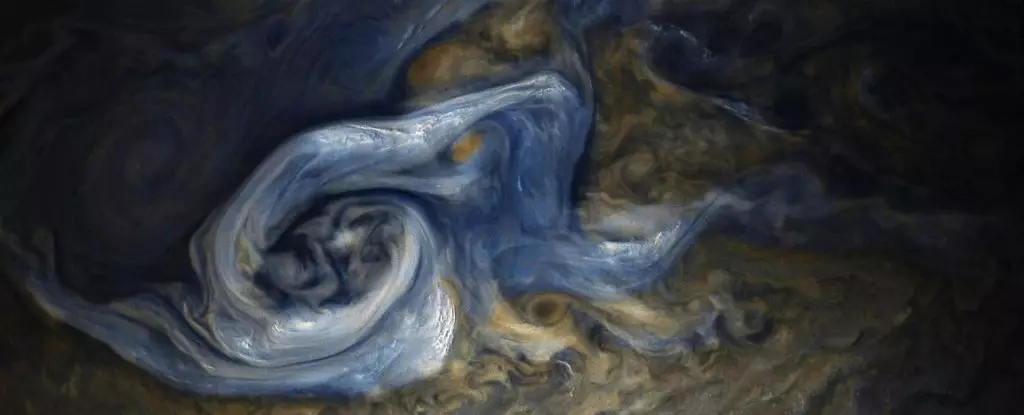Jupiter, the largest planet in our solar system, has long fascinated astronomers and planetary scientists with its tumultuous atmosphere and exuberant weather patterns. From immense storms that rival entire continents to the presence of vibrant bands of clouds, Jupiter’s meteorological phenomena present a unique tapestry of activity that, while occasionally resonant with terrestrial weather systems, defies easy explanation. Recent research has cast light on one particularly bizarre phenomenon: the formation of “mushballs,” a unique colloquial term referring to clumpy amalgamations of water and ammonia that precipitate during Jupiter’s ferocious storms. These icy orbs, akin to slushy snowballs, reveal not just the complexities of Jupiter’s atmosphere but also a potentially universal mechanism shared across other gas giants.
The Birth of the Mushball Hypothesis
In 2020, the advent of modern space exploration and data collection, particularly from the Juno probe, provided scientists with unprecedented insight into Jupiter’s atmospheric dynamics. This mission was crucial in unveiling how extreme weather events on Jupiter might distill the planet’s complex composition. The speculation began when evidence suggested that lightning storms could propel water upwards, carrying it into a realm of freezing temperatures where it would interact with ammonia vapor. Here, researchers hypothesized that the hydrogen bonding of these two chemicals could form a unique state that could yield mushballs under the right conditions. This led to the startling notion that thunderstorm processes on Jupiter could, paradoxically, create a form of frozen precipitation not seen on Earth.
Data Revelation: Eavesdropping on a Lightning Storm
The investigation into mushball formation required a detailed examination of observational data gathered during a significant lightning event captured by Juno and the Hubble Space Telescope. Chris Moeckel and his colleagues pored over this data, focusing particularly on radio emissions and various wavelengths of light. What became evident was the three-dimensional structure of Jupiter’s atmosphere, indicating that the storms reach significantly deeper than previously thought — extending potentially up to 150 kilometers below the appearance of the cloud tops. This depth challenged long-standing perceptions that the visible atmosphere was representative of the entirety of Jupiter’s weather systems, indicating that rich and complex processes underlie the disturbances we observe.
The Mechanism of Mushball Formation
Moeckel’s team’s investigation was not without its hurdles; it took extensive work to affirm the hypothesis of mushball formation. The core of the mechanism involves robust updrafts that carry water high above the cloud layers, where it collides with ammonia gas, allowing the concoction of ice slush balls laden with moisture. These mushballs then cascade back down through the atmosphere, effectively depleting ammonia from the upper layers while injecting it into deeper atmospheric regions. This extraordinary process bears implications not only for Jupiter’s ammonia distribution but also serves as an explanation for phenomena previously shrouded in ambiguity.
Beyond Jupiter: Universal Implications for Planetary Science
The beauty of this research lies in its potential implications extending beyond Jupiter. If such a unique weather phenomenon exists on the largest planet in our solar system, could similar mechanisms be responsible for atmospheric phenomena observed on other gas giants like Saturn, Uranus, or Neptune? The exploration of mushballs encourages scientists to examine interplanetary weather systems through a broader lens, including the possibility that varying ratios and interactions of compounds could yield multifaceted results across celestial bodies. Understanding these mechanisms could revolutionize our comprehension of atmospheres not only within our solar system but also in exoplanets inhabiting distant star systems.
Unraveling the Mysteries of Atmospheric Science
The discovery of mushballs is an exciting chapter in the ongoing exploration of planetary atmospheres. It sheds light on how we must think outside the box when interpreting atmospheric behaviors and physical phenomena. The unexpected behaviors of gas giants reflect complex interactions between temperature, pressure, and chemical compositions, and as we continue to study these systems, the vast diversity of planetary weather mechanisms may start to reveal themselves. As astronomical technology evolves, the path to understanding Jupiter’s atmospheric complexities may lay the groundwork for elucidating other cosmic enigmas, fostering a deeper connection with the mechanisms that govern the universe itself.


Leave a Reply